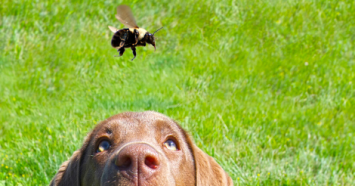
Insects abound in the spring and summer and due to their smaller stature and curious nature, insect bites can be more dangerous in our pets than in people. The pet that carelessly chases a buzzing bee or tramples through an ant bed may learn this the hard way. While a single insect sting is painful for our pets, more than one sting, or a sting inside the mouth, can quickly become a dangerous situation. Get the 411 on bees, wasps, and fire ant stings in pets so you will know what to do should your dog or cat find themselves the target of a summer insect.
Bees & wasps: Bees leave behind their stingers after attacking their target so if you find a stinger on your pet, you'll know it is from a bee. If a stinger is still present, try to remove it by scraping it with a fingernail or a credit card. Avoid using tweezers to remove it unless absolutely necessary as this may force more venom out of the stinger.
If you don't see a stinger, a wasp may have stung your pet. Wasp stingers are not barbed but are more painful, and if provoked these insects can sting multiple times. As with bees, the venom from multiple stings can cause organ damage and death.
Fire ants: Fire ants are commonly attracted to pet food so make sure not to leave pet food out. If your pet is bitten, carefully brush off the fire ants that you see on your pet while wearing gloves. Trying to get them off hastily by swatting at them or spraying your pet with water may aggravate them more and increase their bites. Multiple bites may require veterinary treatment. Small dogs and cats may require veterinary treatment for even one or two bites.
Allergic reactions
Like people, some pets are highly allergic to certain insect stings. If your pet experiences a severe reaction, whether you are certain it was a bite or not, seek emergency veterinary care right away. Signs of a severe anaphylactic reaction include:
Difficulty breathing (wheezing, rapid breathing)
A large amount of swelling extending away from the sting site
Pale gums
General weakness or collapse
These symptoms indicate a life-threatening emergency and you should seek immediate medical attention for your pet.
Pain and itch relief
For non-serious reactions to bites, it is important to administer a remedy for the pain. Applying a weak mixture of water and baking soda to the affected area will help reduce pain. You can also wrap ice or an icepack in a towel and apply it to the wound to reduce swelling and pain. Calamine lotions can provide relief from itching and help prevent the pet from scratching.
Benadryl (diphenhydramine) can also help relieve itching and reduce swelling, while reducing any allergic reaction. Ask your veterinarian ahead of time what the appropriate dose of Benadryl is for your pet should he have a minor reaction.
Prevention
To minimize exposure to insect stings you will need to routinely monitor your yard for hives, nests, and ant beds. Limit pets’ access to flower beds, a favorite of buzzing insects. Check the eaves of houses and in trees for nests. Some wasps build their nests in the ground, so pay careful attention to where your dog may be digging when he is outside. It is always a good idea to monitor your property for nests and beds and have them removed or treated when detected.